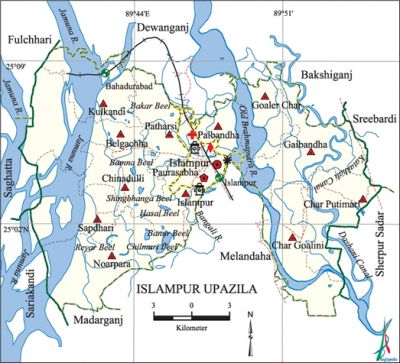Islampur Upazila
Islampur Upazila (jamalpur district) area 353.31 sq km, located in between 24°57' and 25°10' north latitudes and in between 89°38' and 89°56' east longitudes. It is bounded by dewanganj and bakshiganj upazilas on the north, madarganj and melandaha upazilas on the south, sherpur sadar and sreebardi upazilas on the east, saghatta, fulchhari and sariakandi upazilas on the west.
Population Total 298429; male 148439, female 149990; Muslim 294161, Hindu 4146, Christian 3 and others 119.
Water bodies Main rivers: jamuna, old brahmaputra, bangali; Bamna Beel, Bakar Beel, Shingbhanga Beel, Hasal Beel, Banur Beel, Chilmari Beel, Rieyar Beel, and Katakhali Canal and Dashani Canal are notable.
Administration Islampur Thana was formed in 1914 and it was turned into an upazila in 1983.'
| Upazila | ||||||||
| Municipality | Union | Mouza | Village | Population | Density (per sq km) | Literacy rate (%) | ||
| Urban | Rural | Urban | Rural | |||||
| 1 | 12 | 72 | 130 | 38568 | 259861 | 845 | 47.9 | 27.3 |
| Municipality | ||||||||
|
Area |
Ward |
Mahalla |
Population |
Density |
Literacy rate (%) | |||
| 16.66 | 9 | 18 | 38568 | 2315 | 47.9 | |||
| Union | ||||
| Name of union and GO code | Area (acre) | Population | Literacy rate (%) | |
| Male | Female | |||
| Islampur 55 | 3717 | 8630 | 8879 | 30.3 |
| Kulkandi 63 | 7024 | 5221 | 5604 | 31.0 |
| Gaibandha 39 | 8871 | 16225 | 15555 | 26.5 |
| Goaler Char 47 | 7591 | 14673 | 14534 | 21.3 |
| Char Goalini 15 | 4392 | 9174 | 9108 | 19.1 |
| Char Putimari 23 | 8585 | 15017 | 14571 | 21.8 |
| Chinadulli 31 | 5933 | 12488 | 13256 | 34.9 |
| Noarpara 71 | 8217 | 12767 | 12832 | 24.0 |
| Patharsi 87 | 8451 | 13802 | 14207 | 38.7 |
| Palbandha 79 | 3744 | 6775 | 6614 | 35.8 |
| Belgachha 13 | 8312 | 10066 | 10733 | 23.2 |
| Sapdhari 94 | 8352 | 4570 | 4560 | 18.4 |
Source Bangladesh Population Census 2011, Bangladesh Bureau of Statistics.
Archaeological heritage and relics Tomb of Hazrat Shah Kamal (R) at Durmuth, Kuthibari of Pradyut Thakur, Jeu Mandir, Kali Mandir, Durgabari and tomb of Itapir.
Historical events During the reign of Emperor Jahangir the Subedar of Bangla islam khan lived in this region for some time; it is believed that Islampur is named after him.
War of Liberation More than 100 local residents of the upazila formed resistance against the Pak army in April 1971 but they were not very successful because they did not have sufficient arms and ammunitions. 30 freedom fighters were arrested and later killed by the Pak army. The freedom fighters of the upazila conducted attacks on river vessels carrying Pakistani soldiers and also conducted operations at Burungi Beel and Islampur Telephone exchange Office. Mass graves have been discovered at three places (Kulkandi, Upazila Complex, Mosharafganj) of the upazila.
For details: see ইসলামপুর উপজেলা, বাংলাদেশ মুক্তিযুদ্ধ জ্ঞানকোষ (Encyclopedia of Bangladesh War of Liberation), বাংলাদেশ এশিয়াটিক সোসাইটি, ঢাকা ২০২০, খণ্ড ১।

Religious institutions Mosque 325, temple 11.
Literacy rate and educational institutions Average literacy 30.1%; male 33.5%, female 26.7%. Educational institutions: college 8, secondary school 37, primary school 150, technical educational institution 2, KG school 8, BRAC school 78, madrasa 86. Noted educational institutions: Islampur JJKM Girls' High School and College (1917), Islampur College (1970), Islampur Nekjahan High School (1915), Dewanganj Government High School (1919), Neelkhiya RJ Pilot High School (1935), Dengargarh Nurul Huda Alim Madrasa (1831).
Newspapers and periodicals Weekly: Urmi Bangla, Gangchil, Mayur (irregular).
Cultural organisations Library 36, club 55, theatre group 1, cinema hall 1, women's organisation 2, playground 17. Noted Cultural organisations: hasan hafizur rahman Smriti Sangha Library (1984), Shahid Major General khaled mosharraf (Bir Uttam) Smriti Samsad (1995).
Main sources of income Agriculture 68.83%, non-agricultural labourer 3.45%, industry 0.55%, commerce 10.69%, transport and communication 2.21%, service 4.27%, construction 0.61%, religious service 0.21%, rent and remittance 0.24% and others 8.93%.
Ownership of agricultural land Landowner 54.50%, landless 45.50%; agricultural landowner: urban 36.01% and rural 57.41%.
Main crops Paddy, jute, wheat, mustard, sugarcane, potato, pulse, brinjal, vegetables.
Extinct or nearly extinct crops Peanut, kaun, corn.
Main fruits Mango, jackfruit, coconut, papaya, banana.
Fisheries, dairies and poultries This upazila has a number of fisheries, dairies and poultries.'
Communication facilities Pucca road 116 km, semi-pucca road 4 km, mud road 478 km; railways 15 km; waterways 25 km.
Extinct or nearly extinct traditional transport Palanquin, soari, bajra, bhela.
Cottage industries Weaving, goldsmith, blacksmith, brass work, potteries, bamboo work, cane work, jute work, cotton work.
Hats, bazars and fairs Hats and bazars are 8, most noted of which are Dharmakura, Guthail and Islampur bazars.
Main exports Rice, jute, sugarcane, potato, brinjal.
Access to electricity All the wards and unions of the upazila are under rural electrification net-work. However 38.3% of the dwellings have access to electricity.
Sources of drinking water Tube-well 95.8%, tap 0.1% and others 4.1%.
Sanitation 46.6% of dwelling households of the upazila use sanitary latrines and 41.2% of dwelling households use non-sanitary latrines; 12.2% of households do not have latrine facilities.
Health centres Upazila health complex 1, family planning centre 12, satellite clinic 3, clinic 6, community clinic 40.
NGO activities brac, asa, Unnayan Sangha, Progress. [Sayed Abdullah Al Mamun Chowdhury]
References Bangladesh Population Census 2001 and 2011, Bangladesh Bureau of Statistics; Cultural survey report of Islampur Upazila 2007.'
